News
Best Paper Award at MICCAI 2014
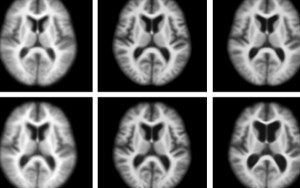 Congratulations to PhD student Miaomiao Zhang, who won the MICCAI 2014 Young Scientist Award (a.k.a., best paper award) for her paper:
Congratulations to PhD student Miaomiao Zhang, who won the MICCAI 2014 Young Scientist Award (a.k.a., best paper award) for her paper:M. Zhang, P. T. Fletcher, Bayesian Principal Geodesic Analysis in Diffeomorphic Image Registration, MICCAI 2014.
MICCAI is the premiere venue in medical image analysis with ~1000 attendees.
UDCC Open House
 Wednesday, September 17th 2014
Wednesday, September 17th 201410 am to 3 pm
University of Utah
Warnock Engineering Building, Catmull Gallary
72 So. Central Campus Dr.
The first UDCC open house will bring together our consortium partners and engineering students to a single venue. Partners interested in sponsoring student internships through the new Data Center Engineering Certificate will be present for questions, and students will have the opportunity to hear from and engage with some of our nation's leading experts in the field. You can visit our website or email us for more information.
UV-CDAT Receives Outstanding Partnership Award from the FLC
 The Federal Laboratory Consortium for Technology Transfer (FLC) Far-West Region presents Outstanding Partnership award to Ultrascale Visualization Climate Data Analysis Tools. This is a joint partnership with Lawrence Livermore National Laboratory, New York University, Kitware, inc., Goddard Space Flight Center, Earth System Research Laboratory, Tech-x Corporation, Oak Ridge National Laboratory, Lawrence Berkeley National Laboratory, Los Alamos National Laboratory, and the University of Utah.
The Federal Laboratory Consortium for Technology Transfer (FLC) Far-West Region presents Outstanding Partnership award to Ultrascale Visualization Climate Data Analysis Tools. This is a joint partnership with Lawrence Livermore National Laboratory, New York University, Kitware, inc., Goddard Space Flight Center, Earth System Research Laboratory, Tech-x Corporation, Oak Ridge National Laboratory, Lawrence Berkeley National Laboratory, Los Alamos National Laboratory, and the University of Utah.
Paper Featured on Cover of Journal of Cardiovascular Electrophysiology
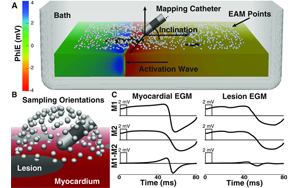 Congratulations to Josh Blauer, Darrell Swenson, and Rob MacLeod, et. al. whose paper:
Congratulations to Josh Blauer, Darrell Swenson, and Rob MacLeod, et. al. whose paper:J.J.E. Blauer, D. Swenson, K. Higuchi, G. Plank, R. Ranjan, N. Marrouche, and R.S. MacLeod. “Sensitivity and Specificity of Substrate Mapping: An In Silico Framework for the Evaluation of Electroanatomical Substrate Mapping Strategies,” In Journal of Cardiovascular Electrophysiology, In Journal of Cardiovascular Electrophysiology, Vol. 25, No. 7, pp. 774--780. May, 2014.
is featured on the cover of the July 2014 issue of the Journal of Cardiovascular Electrophysiology.
Introducing Deformetrica
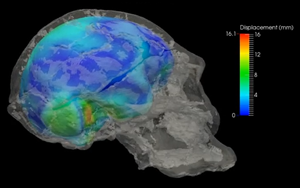 Developed in collaboration with INRIA, and available for download at www.deformetrica.org, Deformetrica is a software for the statistical analysis of 2D and 3D shape data. It essentially computes deformations of the 2D or 3D ambient space, which, in turn, warp any object embedded in this space, whether this object is a curve, a surface, a structured or unstructured set of points, or any combination of them.
Developed in collaboration with INRIA, and available for download at www.deformetrica.org, Deformetrica is a software for the statistical analysis of 2D and 3D shape data. It essentially computes deformations of the 2D or 3D ambient space, which, in turn, warp any object embedded in this space, whether this object is a curve, a surface, a structured or unstructured set of points, or any combination of them. Deformetrica comes with two applications: 1. Registration, which computes the best possible deformation between two sets of objects, and 2. Atlas construction, which computes an average object configuration from a collection of object sets, and the deformations from this average to each sample in the collection.
MRL Podcast: Deformation Causes Vascular Alignment During Angiogenesis
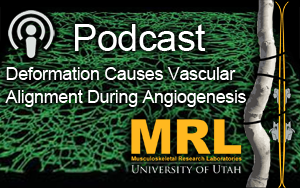 Jeff Weiss speaks with Deputy Editor of the AJP Heart and Circulatory Physiology Journal Dr. Merry Lindsey about the recent MRL publication:
Jeff Weiss speaks with Deputy Editor of the AJP Heart and Circulatory Physiology Journal Dr. Merry Lindsey about the recent MRL publication:Clayton J. Underwood, Lowell T. Edgar, James B. Hoying, Jeffrey A. Weiss "Cell-generated traction forces and the resulting matrix deformation modulate microvascular alignment and growth during angiogenesis" Am J Physiol Heart Circ Physiol, published July 15, 2014. DOI: 10.1152/ajpheart.00995.2013.
Listen to the podcast here.
Miriah Meyer Receives NSF CAREER Award
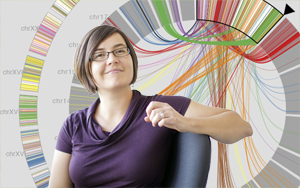 Congratulations to Dr. Miriah Meyer who has been awarded an NSF CAREER Award for her proposal, Design Decision Patterns for Visualizing Multivariate Graphs, with a budget of $500K.
Congratulations to Dr. Miriah Meyer who has been awarded an NSF CAREER Award for her proposal, Design Decision Patterns for Visualizing Multivariate Graphs, with a budget of $500K.See also: USTAR InnovationUtah Insights: "USTAR Investigator Receives CAREER Award"

FEBio 2.0 Released
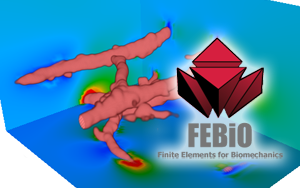 It’s with great pleasure that we announce the release of version 2.0 of FEBio (Finite Elements for Biomechanics). This new version can be downloaded here. FEBio is an open-source finite element package, specifically designed for solving problems in the field of computational biomechanics. This new version includes some major changes and contains a number of new and exciting features. Some of the noteworthy changes and additions are listed below.
It’s with great pleasure that we announce the release of version 2.0 of FEBio (Finite Elements for Biomechanics). This new version can be downloaded here. FEBio is an open-source finite element package, specifically designed for solving problems in the field of computational biomechanics. This new version includes some major changes and contains a number of new and exciting features. Some of the noteworthy changes and additions are listed below.
Chris Butson Joins the SCI Institute as an Associate Professor of Bioengineering
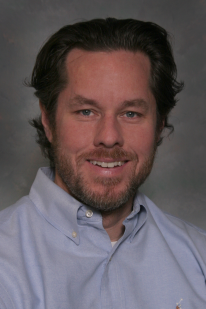 Dr. Butson received a B.S. in Mechanical Engineering from the University of Maryland, M.S. in Electrical Engineering from George Washington University and Ph.D. in Biomedical Engineering from the University of Utah. He completed post- doctoral training at the Cleveland Clinic and for the last six years has been a member of the Biotechnology & Bioengineering Center at the Medical College of Wisconsin (MCW) where he was an Associate Professor in the Departments of Neurology, Neurosurgery, Psychiatry & Behavioral Health at MCW, and an Adjunct Professor in the Department of Biomedical Engineering at Marquette University. He is an active member of the Society for Neuroscience (SFN), the Institute of Electrical & Electronics Engineers (IEEE) and the Engineering in Medicine & Biology Society (EMBS).
Dr. Butson received a B.S. in Mechanical Engineering from the University of Maryland, M.S. in Electrical Engineering from George Washington University and Ph.D. in Biomedical Engineering from the University of Utah. He completed post- doctoral training at the Cleveland Clinic and for the last six years has been a member of the Biotechnology & Bioengineering Center at the Medical College of Wisconsin (MCW) where he was an Associate Professor in the Departments of Neurology, Neurosurgery, Psychiatry & Behavioral Health at MCW, and an Adjunct Professor in the Department of Biomedical Engineering at Marquette University. He is an active member of the Society for Neuroscience (SFN), the Institute of Electrical & Electronics Engineers (IEEE) and the Engineering in Medicine & Biology Society (EMBS). Topological Methods in Data Analysis and Visualization III
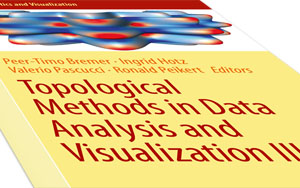 Congratulations to Valerio Pascucci and Peer-Timo Bremer whose co-edited book "Topological Methods in Data Analysis and Visualization III" has just been published.
Congratulations to Valerio Pascucci and Peer-Timo Bremer whose co-edited book "Topological Methods in Data Analysis and Visualization III" has just been published.
Kedar Aras Wins Young Investigator Competition
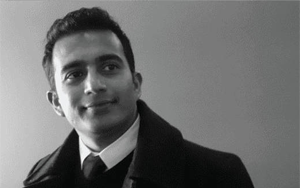 Congratulations to Kedar Aras who won the Young Investigator prize at the 39th Annual International Society for Computerized Electrocardiology (ISCE) conference on April 29th. Judges evaluated finalist presentations based on the originality of the science, quality of the study, and the clarity of the presentation and Q&A. Each speaker was given 15 minutes for their presentation followed by a 15 minute Q&A session.
Congratulations to Kedar Aras who won the Young Investigator prize at the 39th Annual International Society for Computerized Electrocardiology (ISCE) conference on April 29th. Judges evaluated finalist presentations based on the originality of the science, quality of the study, and the clarity of the presentation and Q&A. Each speaker was given 15 minutes for their presentation followed by a 15 minute Q&A session.




